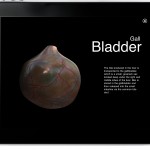![]() Frog Dissection ($4.99) by Emantras, Inc., is an educational app that takes you through the process of dissecting a frog. The app is beautifully designed and is easy to use, with both written and audio instructions. Not only does Frog Dissection explain how to dissect, but it also provides additional information on frog organs, the frog life cycle, and other interesting frog facts. Emantras received PETA’s Mark Twain Ethical Science Award for this app, which offers a humane alternative to live animal dissection.
Frog Dissection ($4.99) by Emantras, Inc., is an educational app that takes you through the process of dissecting a frog. The app is beautifully designed and is easy to use, with both written and audio instructions. Not only does Frog Dissection explain how to dissect, but it also provides additional information on frog organs, the frog life cycle, and other interesting frog facts. Emantras received PETA’s Mark Twain Ethical Science Award for this app, which offers a humane alternative to live animal dissection.
The opening screen is quite striking with its black background, green leaf, and yellow frog. From here you can access the virtual dissection sequence. Other educational materials are found here as well, including “All About Frogs,” a multi-chapter, illustrated discussion of frogs’ classification, appearance, life cycle, etc. “Human vs. Frog” compares the bodies, circulatory systems, digestive systems, and respiratory systems of humans and frogs. “Wet Lab Processes” is a simple guide to each step in a dissection.
Other educational materials are found here as well, including “All About Frogs,” a multi-chapter, illustrated discussion of frogs’ classification, appearance, life cycle, etc. “Human vs. Frog” compares the bodies, circulatory systems, digestive systems, and respiratory systems of humans and frogs. “Wet Lab Processes” is a simple guide to each step in a dissection.
 The dissection process is as realistic as possible (without the ghastly smell of formaldehyde). The app guides the student through each step with both written instructions (which appear on a lab notebook) and audio instructions. A soothing female voice patiently explains which instruments to use and how to use them. The student pins the frog to the dissection pan, marks the incisions, and carefully cuts the frog open with a scalpel and scissors.
The dissection process is as realistic as possible (without the ghastly smell of formaldehyde). The app guides the student through each step with both written instructions (which appear on a lab notebook) and audio instructions. A soothing female voice patiently explains which instruments to use and how to use them. The student pins the frog to the dissection pan, marks the incisions, and carefully cuts the frog open with a scalpel and scissors.
 Using the forceps, the frog’s skin and muscle are pulled away to reveal the inner organs.
Using the forceps, the frog’s skin and muscle are pulled away to reveal the inner organs.
 Once the dissection is complete, the student can touch each organ to see a 3D model and learn more about the organ’s function.
Once the dissection is complete, the student can touch each organ to see a 3D model and learn more about the organ’s function.
 What’s Macgasmic: Frog Dissection is a terrific way for students to learn about dissection. The app makes the experience as interactive as possible and offers in-depth information about frogs’ organs, life cycles, and habitat. The 3D models of the organs are beautifully rendered and being able to touch each organ to learn more about it is intuitive.
What’s Macgasmic: Frog Dissection is a terrific way for students to learn about dissection. The app makes the experience as interactive as possible and offers in-depth information about frogs’ organs, life cycles, and habitat. The 3D models of the organs are beautifully rendered and being able to touch each organ to learn more about it is intuitive.
 What’s Not: Unfortunately, for some the app might seem much too simple. The dissection sequence is thorough, but simply sliding one’s finger on the line to “cut” the frog open obviously does not mimic the real thing. A student using Frog Dissection does not need any skill to dissect the virtual frog, whereas in a real lab situation, a student would have to exhibit patience and care to avoid damaging the specimen. The information in the app is quite basic and the illustrations look like those you might find in an elementary or middle-school textbook.
What’s Not: Unfortunately, for some the app might seem much too simple. The dissection sequence is thorough, but simply sliding one’s finger on the line to “cut” the frog open obviously does not mimic the real thing. A student using Frog Dissection does not need any skill to dissect the virtual frog, whereas in a real lab situation, a student would have to exhibit patience and care to avoid damaging the specimen. The information in the app is quite basic and the illustrations look like those you might find in an elementary or middle-school textbook.
Nevertheless, Frog Dissection offers a much-needed alternative to using live specimens in science classes. If the real purpose of dissection is to teach students about the organs of a frog, then developing scalpel and skin-flap-pinning skills seems to be quite unnecessary. Using an application like this would simplify lab work and provide a practical solution for those who have ethical concerns about using animals for science. Certainly, this app is not sophisticated enough for upper-level education, but it is an excellent option for elementary and middle-school children.
Now, could you kind folks at Emantras please get on the ball and do a Fetal Pig Dissection App? My son is supposed to dissect one in his seventh-grade science class this year and his mommy is appalled. What happened to frogs, middle school science teachers? Did E.T. get to you?














